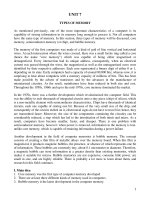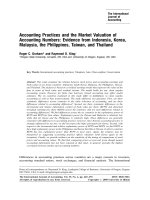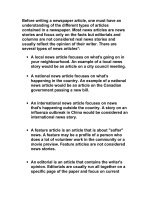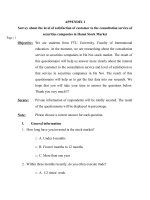Vietnamese Capital Market: Types of securities Participants Presentation
Bạn đang xem bản rút gọn của tài liệu. Xem và tải ngay bản đầy đủ của tài liệu tại đây (1.31 MB, 24 trang )
Vietnamese
Capital Market
Types of securities &
Participants
Historical development of Securities in
Vietnam
Major participants in the Vietnamese
capital market
Types of securities traded on the market
Issuing securities
Outline
Historical Development
On July 11th, 1998, The Prime Minister issued Decision No.
127/1998/QD-TTg on the establishment of two Securities Trading
Centers in Hanoi and Ho Chi Minh City under the management of the
State Securities Commission (SSC) of Vietnam.
The Stock Trading Center of Vietnam is also the official mechanism.
There are 120 listed bonds with a total market capitalization of
US$866m.
HoChiMinh Stock exchange (HOSE)
Augurated on July 20, 2000.
Trading commenced on July 28, 2000 with 2 types
of listing stocks in the first trading session.
Transferred the Ho Chi Minh
City Securities Trading Center
to HoChiMinh Stock Exchange
(HOSE) on July 11th, 2007.
Hanoi Stock Exchange (HNX)
Is a trading market for stocks of small and medium-sized
enterprises in Hanoi
Was officially inaugurated putting up a new milestone of
Vietnam’s securities market on March 08th, 2005.
Was awarded Third-Rank Labor
Medal by the State for
outstanding achievements in the
development of the stock market
in 2008.
Issuers
Dealers
Regulators
Investors
Major participants
Issuers
Listed
companies
Unlisted public
companies
Government
Number: >300
16% of them made loss
and 60% had profits
decreased in 2011.
80% were underpriced.
Number: >450
Issuing shares to
UPCOM
Market capitalization
from bonds: VND
81.5 trillion (2011)
Total market capitalization of VND 602 trillion,
accounting for 25% of GDP in 2011.
Dealers
Securities
companies (103)
Fund management
companies (47)
Operations: Securities
brokerage, underwriting,
securities buying and selling,
securities investment
advisory
>60 made loss in 2011.
Operations: securities
investment fund management
and securities portfolio
management
24 made loss in 2011.
Regulators
State Securities Commission of
Vietnam (SSC): was established in 1996,
belonged to Ministry of Finance
Stock Exchange:
Ho Chi Minh Stock Exchange (HOSE) – 2000
Hanoi Stock Exchange (HNX) -2005
Investors
Individual Institutional Foreign
>95% of investors in
Vietnamese capital
market
Small investment
capital
Very small portion
24 Investment
Funds
Contains 15.589 foreign
investors, including 1.741
institutions and 13.848
individuals up to 2012.
Decreased by 70% compared
to 2011.
I
•
In the bond market
II
•
In the stock market
III
•
In the derivative instrument
market
Types of securities
I. In the bond market
Goverment bonds
•
Issued by a national government to support country
development projects.
•
Are usually denominated in the country's own currency.
•
Refer to as risk-free bonds.
•
Have no tax-paid but low rate of return.
•
Issue on the primary market by bidding method.
Yield movements
Corporate bonds
•
Issued by a corporation.
•
Have a higher risk of default in compare with
government bonds.
•
Have to pay taxes on the interest earned and also
have a higher rate of return.
•
In Vietnam, Total LCY corporate bonds
outstanding rose 18.9% y-o-y to VND33 trillion in
2Q11 but fell 5.9% q-o-q (Table 2)
II. In the stock market
Common shares:
•
Ownership
•
Voting privileges
•
Right to dividends
•
Right to information
•
Pre-emptive right
In Vietnam, stocks are
sold and bought actively
in secondary market.
Preferred shares:
•
Ownership
•
Nonvoting
•
Dividends
•
Adjustable rate
•
Cumulative or non-cumulative
•
Convertible
In Vietnam, the preferred share
is essentially issued internally.
III. In the derivative instrument
market
Options contract
•
Financial contract between two parties, the buyers and the
sellers.
•
Give the option-buyer the right but not the obligation to buy
or sell.
•
The price established is known as exercise price, or strike
price. That is the price at the day which contract is able.
•
Not be exercised if it is not in the option-buyer’s best
interest.
•
Divided into two types: Call option and Put option
market
Vanilla options
1. Call option:
Give the option-buyers the right to buy.
Buyer gains if the price of the underlying assets
higher than the exercise price.
2. Put option:
Give the option-buyer the right to sell.
Buyer benefits if the price of the underlying assets
is below the exercise price
market (cont.)
Swaps
•
Is used to exchange cash flows between 2
party's financial instruments.
•
Hedge the interest risk and exchange rate risk.
•
Includes two types that are Interest Rate Swaps
and Cross Currency Swaps.
METHODS
OF
ISSUEING
PRIVATE
PLACEMENT
PUBLIC PLACEMENT
IPO
SPO
ISSUING SECURITIES
Reasons:
•
Below standard of public
placement
•
Small mobilized capital
•
Relationships
maintenance
•
Staff motivation
•
Others
Investors:
Insurance companies,
Pension funds,
Investment banks,
Mutual funds, etc.
Reasons:
•
Large mobilized capital
•
Company promotion
•
Copartner finding
Initial Public Offering
Seasoned Public
Offering
Reference
/>
http
://www.ssc.gov.vn/portal/page/portal/ubck/1096905?p_
page_id=1096905&pers_id=1108311&folder_id=&
item_id=7173508&p_details=1
http://
www.ssc.gov.vn/portal/page/portal/ubck/gthieu/ttgdck
/>ng-khoan-tieu-bieu-nam-2011-tpov.html
/>m-2011-thi-truong-lao-doc-niem-tin-sut-giam.htm
/>ao-dich-cap-moi-cho-nha-dau-tu-nuoc-ngoai-giam-70.ht
m









